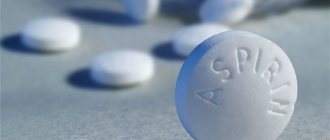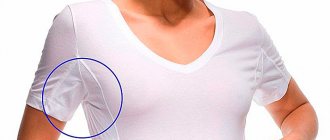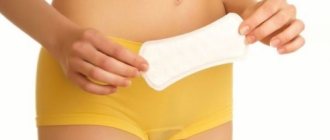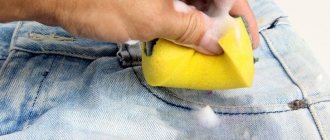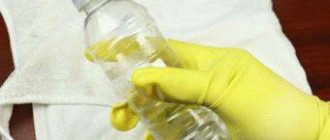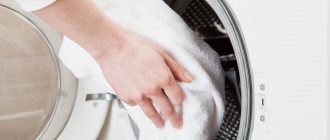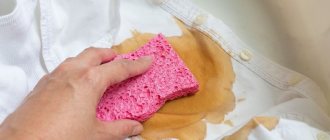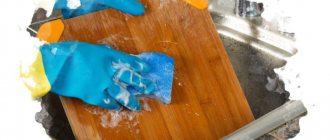White clothes look smart, but often their appearance is spoiled by antiperspirant stains and yellow traces of sweat under the arms. Affordable home remedies that can be used for T-shirts, shirts, blouses, as well as underwear (panties and bras) will help you save your favorite item. In our article we will tell you how to remove yellow stains on armpits on white.
Sweat stains under the arms on white clothes spoil the appearance of the garment and cause an unpleasant odor, so it is important to know how to get rid of them
Features and Recommendations
In general, sweating for thermoregulation activates sweat glands throughout the body, while strong emotions are triggered in specific areas such as the palms, lower feet, armpits and sometimes the forehead.
In some cases of intense training, a person may lose 1-2 liters of sweat per hour.
Sweat is not pure water, it always contains various dissolved substances such as traces of minerals, lactic acid and urea. In addition, the composition of sweat depends on the cause of the discharge.
- There are 2 types of sweat glands - eccrine and apocrine. For the purpose of thermoregulation, the composition of sweat is mainly water.
- Under stress, sweat contains an oily, opaque secretion that is initially odorless.
- The characteristic odor occurs after bacteria consume it.
- Sweat odor can also be affected by medications, kidney failure, high blood sugar, hormonal balance, and even diet.
In some people, the body's mechanisms for regulating body temperature through sweating are overactive, and it is possible that the amount of sweating is 4-5 times greater than normal. This can occur in the armpits, feet and hands. The condition is not life-threatening, but can cause some inconvenience.
In some cases, this excessive sweating may only occur during sleep.
Not sweating can also be dangerous because it increases the risk of overheating. Newborns and small children do not have such developed thermoregulation and are more likely to suffer from heat stroke.
Chromohidrosis - what does it mean?
A variety of shades of sweat with chromohidrosis.
Human sweat can take on more than just yellow hues. It happens:
- blue;
- green;
- red;
- and even black.
This phenomenon in medicine is called chromohidrosis and develops, most often, against the background of existing problems with sweating, for example, with hyperhidrosis.
The reasons are similar to those mentioned when describing the problem of yellow sweat:
- influence of harmful chemical compounds from the external environment;
- insufficient body hygiene.
Chromohidrosis is classified into:
- false (pseudochromohidrosis);
- true.
To understand how they differ, it is worth taking a closer look at each variety.
Pseudochromohidrosis
It is characterized by the release of normal sweat secretion, which becomes colored while on the skin. Workers in hazardous industries often suffer from this problem. Sweat staining does not occur on the entire body, but locally. The color of the discharge depends on the chemicals a person is dealing with:
- the blue tint comes from methylene blue, which is used to dye fabrics in the textile industry;
- green – due to the influence of copper and brass;
- red comes from working with potassium permanganate. It is often used as an oxidizing agent in chemical industries.
Bacteria and fungi that live in the area of increased sweating in people with hyperhidrosis can change the color of sweat. They can give sweaty skin ochre-brown, reddish and even black hues.
Sometimes the color of sweat secretion simply takes on the color of clothing dyes.
True chromohidrosis
The phenomenon is quite rare, characterized by abnormalities in the structure of the sweat glands and hereditary predisposition. With this type of pathology, sweat initially has a yellow color, but under the influence of various factors it acquires the same range of shades that the false form gives.
Tips for regulating sweating
Sweating is a normal physiological process, but if you are concerned, you can use various methods to reduce the amount you sweat.
Wear clothes made from natural fabrics and those that do not emit steam and allow the skin to breathe.
- Dress in several layers of clothing so you can undress as temperatures rise.
- Wash off sweat from your face and body in a timely manner to avoid the unpleasant odor of bacteria.
- If you sweat excessively due to high temperatures, exercise, or illness, you need to drink more fluids and electrolytes to restore them.
- Avoid foods and drinks that cause you to sweat, such as spicy foods, alcohol, coffee and more.
If your sweating is caused by an illness or taking certain medications, you may want to talk to your doctor about other alternatives.
The most common cause of concern is armpit sweating. Deodorants are used to add flavor and mask unpleasant odors. Antiperspirants are used to reduce sweating.
There are hundreds of different products. Some guarantee freshness for 24 hours, others for 48 hours. There are special developments against yellowing of white clothes and the formation of white spots on black ones.
Diagnosis of pathology
Many people are afraid of colored stains from sweat on clothes and bodies. People go to the doctor, and this is the right decision. Especially when you consider the range of possible causes of abnormal sweat.
To understand each specific case, diagnostic measures are carried out, which include:
- examination and collection of anamnesis (information about all diseases of the body identified at the moment);
- microflora testing (to identify pathogenic organisms);
- lumen diagnostics of problem areas of the skin;
- blood and urine tests.
If during the examination there are grounds to suspect the presence of new pathologies, additional research and consultation with more specialized specialists are possible.
What causes stains under the armpits of clothes
White stains on dark clothing are caused by aluminum metal salts. In aerosol forms without water, aluminum salts are in powder form, which can be seen with the naked eye on skin and darker clothing. In sticks and dry deodorants, white spots appear after the water evaporates.
Yellow sweat stains appear gradually.
- They are the result of the interaction of sweat, sebum, washing powder and skin lipids.
- Yellow stains are the result of complex chemical reactions in which pigments adhere to the fine fibers of clothing.
Whether this happens depends on factors such as how often you use deodorant/antiperspirant, how much you use, the chemistry of your sweat, the minerals or trace elements in the water you wash with, the composition of the fabric, and the detergent.
Causes of yellow sweat
Normally, human sweat is transparent and colorless. If it suddenly acquires a tint of color, it means that not everything is in order in the body.
Thus, yellow sweat under the arms and in other places is caused by the production of the pigment substance lipofuchsin, which affects the functions of the sweat glands. Causes of abnormal coloration may include:
- Genetic predisposition, when one of the blood relatives suffers from a similar problem.
- Neglect of personal hygiene rules. Prolonged and repeated exposure of clothing to sweat leads to the appearance of not only stains, but also salt crystals. All this contributes to the rapid growth of pathogenic flora, the formation of an unpleasant odor and the appearance of foci of inflammation on the skin.
- Staying in stressful situations for a long time, when yellow sweat appears from excitement and stains clothes in the areas of excretion.
- Chronic pathologies in the acute stage.
- Unfavorable ecology when there is a high concentration of harmful substances in the soil, water and air.
- Work in “harmful” industries.
Sometimes the sweat secretion has a distinct smell of urine. This means that the filtering function of the kidneys is impaired and there is reason to immediately consult a doctor.
Often, bright, yellow sweat bothers teenagers. During puberty, hormonal changes in the body occur, which may be accompanied, among other things, by abnormally high sweating. Moreover, the secretion has not only color, but also a pungent odor. This situation should not be considered a pathology, because with the completion of puberty the problem goes away.
To solve the issue and eliminate discomfort, proper hygiene and the use of special cosmetics that reduce the amount of sweat secretion and eliminate unpleasant odors are sufficient.
It was mentioned above that lemon-colored sweat can be provoked by reasons related to health problems. One of these is Gilbert's syndrome, a condition in which the blood contains too much indirect bilirubin. It is also called pigmentary hepatosis.
Skin tone in Gilbert's syndrome.
People with this pathology suffer:
- yellowing of the skin and white area of the eyes;
- increased sweating that occurs day and night. The sweat has an ocher tint and a repulsive odor.
This is how the skin color of a person with jaundice differs.
Other symptoms resemble those of jaundice:
- pain appears in the liver area;
- the overall tone of the body decreases;
- high fatigue is noticed;
- sleep is disturbed. This makes a person look tired and irritable during the day;
- heart rate increases;
- chills bother me.
Such a detailed description should give rise to thought for those who, in addition to yellow sweat, suddenly discover symptoms of pigmentary hepatosis. It is important to understand that the condition requires serious medical correction, and therefore you should not delay your visit to the doctor.
Moreover, the cause of the development of Gilbert's syndrome can be such trivial circumstances as:
- taking a number of medications;
- destructive passion for alcoholic beverages;
- the predominance of a large amount of heavy food in the diet - fatty and fried;
- liver dysfunction.
Proper therapy will help get rid of unpleasant symptoms, including the problem of yellow sweat.
How to Remove Stubborn Underarm Stains from Clothes
To remove yellow sweat stains under the armpits, you should not use bleach as it will make the situation worse.
You can use safe substances that are found in almost every home, such as baking soda (sodium bicarbonate), vodka, dish soap, white apple cider vinegar, aspirin tablets, and a combination of baking soda and oxygenated water.
- First, start by preparing to remove the stain by soaking your clothing in warm water.
- Follow label directions to avoid any unpleasant shrinkage or discoloration, especially if you're only soaking the underarm area.
- The stains are caused by a reaction between proteins in sweat and aluminum in cosmetics.
- Immersion in water will help the water-soluble particles stuck between the individual fibers of the fabric fall off.
Make a mixture between your chosen cleaning product and warm water in a separate container. Proportions: 1 part water and 1 part vodka, oxygenated water, white apple cider vinegar or dish soap.
- To make a thicker paste, mix 3 parts baking soda with 1 part water.
- Aspirin tablets are crushed (3-4 pieces) and then mixed with 1 part warm water. Be careful not to inhale dust.
When using baking soda or aspirin paste, apply a thick layer to the affected areas using a toothbrush. If the fabric absorbs the paste, you can add more.
After half an hour, you will see the stain gradually disappear. You can improve the process by adding white apple cider vinegar. Baking soda is the base and vinegar is the acid. As a result of the chemical reaction between the two substances, bubbles will appear, which will bring yellow pigments to the surface.
Leave the soaked clothing to stand for at least 1 hour. During this time, most of the yellow spots will begin to return to their normal color. But if stains form after wearing these clothes for a long time and you have used various deodorants, you can leave the clothes soaked for 1 night.
Wash clothes in the hottest safe water possible. If necessary, you can repeat the steps again until the stain disappears.
When cleaning yellow stains with a water solution, you will need to provide a container large enough to soak the affected area. Dipping all your clothes is not a problem because it is not a harsh bleach.
- If the stains are small, you don’t even need to soak them in a container, but you can pour the resulting solution into a spray bottle and spray the stains generously.
- Leave the clothes on again to allow the active ingredients to take effect. The duration of action depends on how intense the color of the spots is.
- For lighter stains, take 15-30 minutes, and for older, more intense stains, take a few hours, and repeat these steps.
- That is why it is necessary to take action even with slight yellowing of clothes.
How to prevent yellow sweat stains from appearing on clothes
First of all, the choice of cosmetics is important. A deodorant or antiperspirant must not contain aluminum to react with sweat proteins.
- If possible, reduce the amount of deodorant. Spraying heavily on areas that don't usually sweat can also be a bad idea and may lead to less than ideal results.
- After you shower, before putting on your clothes, turn the inside of them over and gently sprinkle baby powder in your armpits to absorb sweat. This is most effective for cotton clothing.
If possible, wear a tank top or T-shirt to avoid direct contact of clothing with your body.
Treat any new spots promptly. The paler the color, the easier it will be to remove it using the methods listed.
Prevention of chromohidrosis
To prevent chromohidrosis, it is recommended:
- bring the drinking regime back to normal;
- Follow the rules of personal hygiene, using soap or other non-aggressive shower products. It is important not to forget to change your underwear and bed linen in a timely manner;
- avoid the influence of stressful situations and cultivate stress resistance;
- use clothes according to the season and weather, suitable size, comfortable cut, made from natural, hygroscopic fabrics;
- balance your diet so that natural fruits and vegetables, as well as dairy products, predominate;
- when working in hazardous industries, use special clothing, shoes and personal protective equipment;
- spend more time in the fresh air;
- take care of strengthening the immune system;
- promptly and completely eliminate health problems.
Thus, excessive body hydration, and therefore the risk of colored sweat, can be prevented and eliminated. To do this, it is important to lead a healthy lifestyle, monitor your condition and not be afraid to visit a doctor.
